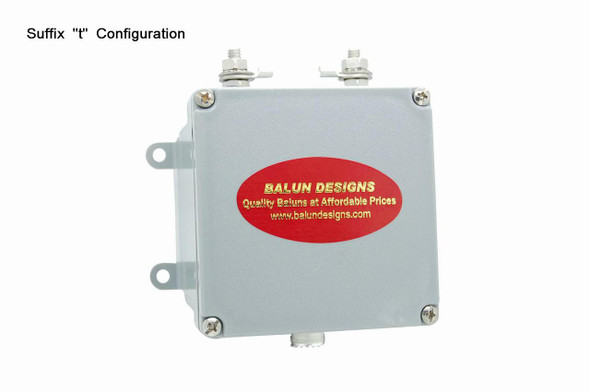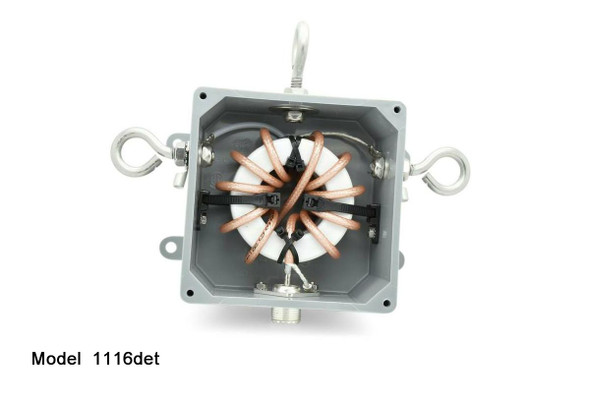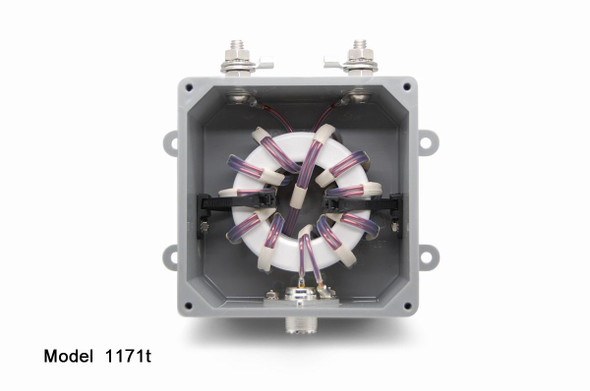Description
We're bring back one of Dr. Jerry Sevick's (W2FMI) original designs but with upgraded windings. This balun was one of our original workhorses and now with new coaxial windings, provides a single core balun optimized for 40 - 10m. By using our low permeability core, this balun provides excellent RF choking and feedline isolation at higher frequencies with lower loss and less heat generation. Excellent balun for RFI suppression on the upper bands, use at feepoint of multi band yagis running mid range power levels and monoband resonant dipoles for 40m and above. Our model 1115d is the dual core, 5kW version of this balun.
Click to Enlarge
Testing done with an AIM-4170uhf Network Analyzer
Please review our Accessories Category for additional RF connector types and mounting options.
This is a current balun and has the widest operating frequency range, lowest core stress and provides the best overall balance of any balun for given cost, size, and weight. This balun is the best type to balance currents on each side of a 1/2 wave dipole or the driven element of a yagi while providing the perfect transition from a balanced antenna to unbalanced coax feedline. Installing this balun will not affect antenna matching unless the feedline is acting as part of the antenna.
Of course, this is not a desirable situation and installing this balun will correct the problem if one exists with the antenna. In beam installations, using a 1:1 balun in series with the feed system can substantially improve the antenna's front-to-back and front-to-side ratios. It does this by providing the antenna's driven elements with balanced current at the feedpoint and by preventing the feedline from acting as part of the antenna.
It is a seldom appreciated fact that feedlines, which are not adequately decoupled, can act as efficient vertical antennas degrading an otherwise excellent radiation pattern. The addition of a 1:1 balun can significantly reduce feedline radiation and dramatically decrease RFI and TVI. Beam antennas especially benefit from improved balanced drive and superior feedline isolation, but even simple dipoles benefit from properly selected and installed 1:1 current baluns. Receiver noise may also be reduced by eliminating signal pickup by the coax shield.
Here are plots of the same dipole with and without a balun.
Notice how the pattern is distorted without the feedline being isolated by the balun:
*** One Exception ***
It must be pointed out that a 1:1 balun should never be used on the second harmonic of a half-wave center-fed dipole fed with coax (like an 80 meter dipole being used on 40 meters). The impedance can be as great as 5,000 ohms creating very high voltages which can bring about voltage breakdown and/or excessive heating. This exception ONLY applies to Coax Fed HALF WAVE CENTER FED DIPOLES WHEN USING A 1:1 BALUN AT THE FEEDPOINT. This caution does not apply to fan dipoles or any dipole that utilizes loading coils to create resonance on the bands in use.
Specifications
| Core Material | Custom mix low permeability ferrite by Fair Rite Products for maximum bandwidth. Large 2.4 inch core is coated and sealed for long term durability. |
| Winding Type |
Single core, coaxial wound 1:1 current balun |
| Winding Material |
Mil Spec 50 ohm coax rated 19kW @ 1MHz, 9kW @ 10 Mhz and 4kW @50MHz. Silver flashed braid and center conductor with solid Teflon dielectric. |
| Power Rating |
1 to 35 MHz - 3kW, 35 to 54 MHz - 2kW, 3kW intermittent All ratings measured with resonant 50 ohm load. |
| Best Frequencies | 7 to 31 MHz |
| Insertion Loss |
Less than .02db |
| Connectors |
SO-239 connectors are gold center conductor with Teflon insulation. Studs and eyebolts are 1/4 inch. Alternate connectors and Mounting Options are available in the Accessories section. |
| Hardware |
All Stainless Steel |
| Enclosure Type |
NEMA rated 4x marine grade junction box for outdoor installations. Cover utilizes integral neoprene gasket for weatherproof integrity. |
| Dimensions | 4x4x2 inches for main body of unit Dimensional Drawing of Standard Enclosure |
| Additional Info | Very high efficiency. Will not heat up or saturate at like many of the "less expensive" designs. |
Warranty Information
Noise Reduction
It is a seldom appreciated fact that feedlines which are not adequately decoupled can act as efficient vertical antennas that degrade an otherwise excellent radiation pattern. The addition of a quality feedline isolation ("choke") balun can significantly reduce feedline radiation and dramatically decrease RFI and TVI. It does this by providing the antenna with balanced current at the feedpoint and by effectively preventing the coax shield from acting as part of the antenna.
While the most common advice is to improve the station's RF ground, the root of the problem is in the poor isolation of the feedline from antenna currents. If your goal is to reduce feedline radiation and improve reception by reducing noise, feedline isolation baluns are an excellent choice. Adding an additonal isolation balun at the point where the feedline exits the near field area of the antenna will substantially reduce unwanted feedline radiation and reception of EMI without the need for improved station grounding.
If your antenna SWR is already low and you wish to reduce feedline radiation and improve reception, a feedline isolation balun is recommended. Adding one at the base of a vertical antenna will substantially reduce unwanted feedline radiation (RFI) by preventing your antenna from using the your coax feedline as a radial. This can also reduce the need for improved station grounding.
Benefits to Vertical Antennas
When quarter-wave antennas are constructed over a near perfect radial system, they have a feedpoint impedance of about 36 ohms. When they are constructed over a less than optimal radial-system there is a loss introduced into the feed system that adds to the 36-ohm figure. This improves the SWR but there is a loss in the efficiency of the antenna, signals transmitted and received have a higher take-off angle and often there is current introduced onto the feedline.
With my SteppIR vertical I use two of these baluns. One at the base of the antenna and another midway along the feedline after the near field of the antenna. You can also install the balun where it enters your shack if you would rather not break the feedline run. The balun balances the RF currents at the antenna, is terrific for keeping RF out of your operating environment and greatly reduces the noise inherent in a vertical by decoupling the feedline.
With a ground-mounted quarter-wave vertical, regardless of the radial situation, but especially with poor radial systems, there is the need for a feedline isolation balun to keep common mode currents off the feedline.
Benefits to Yagis
Yagi antennas especially, benefit from improved balanced drive and superior feedline isolation, but even simple dipoles benefit from properly selected and installed Feedline Isolation baluns. In addition, receiver noise may also be reduced by eliminating stray EMI picked up by the coax shield.
Another very useful application for a feedline isolator is installing them in series with a yagi antenna’s normal feed system. The proper location is between the antenna’s matching device/system and the feedline. Doing this will not affect the antenna and prevents the feedline from acting as part of the antenna. In beam installations, using a feedline isolator in series with the antenna’s feed system can substantially improve the antenna’s front-to-back and front-to-side ratios.























